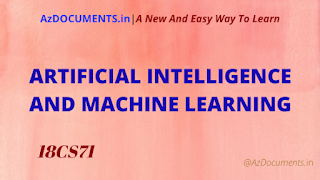ARTIFICIAL INTELLIGENCE AND MACHINE LEARNING
Course Code: 18CS71
CIE Marks: 40
Number of Contact Hours/Week: 4:0:0
SEE Marks: 60
Total Number of Contact Hours: 50
Exam Hours: 03
CREDITS –4
Course Learning Objectives: This course (18CS71) will enable students to:
- Explain Artificial Intelligence and Machine Learning
- Illustrate AI and ML algorithm and their use inappropriate applications
Module 1
What is artificial intelligence?, Problems, problem spaces and search, Heuristic search techniquesTexbook 1: Chapter 1, 2 and 3
RBT: L1, L2
Module 2
Knowledge representation issues, Predicate logic, Representaiton knowledge using rules.Concpet Learning: Concept learning task, Concpet learning as search, Find-S algorithm, Candidate Elimination Algorithm, Inductive bias of Candidate Elimination Algorithm.
Texbook 1: Chapter 4, 5 and 6 Texbook2: Chapter 2 (2.1-2.5, 2.7)
RBT: L1, L2, L3
Module 3
Decision Tree Learning: Introduction, Decision tree representation, Appropriate problems, ID3 algorith.Aritificil Nueral Network: Introduction, NN representation, Appropriate problems, Perceptrons, Backpropagation algorithm.
Texbook2: Chapter 3 (3.1-3.4), Chapter 4 (4.1-4.5)
RBT: L1, L2, L3
Module 4
Bayesian Learning: Introduction, Bayes theorem, Bayes theorem and concept learning, ML and LS error hypothesis, ML for predicting, MDL principle, Bates optimal classifier, Gibbs algorithm, Navie Bayes classifier, BBN, EM AlgorithmTexbook2: Chapter 6
RBT: L1, L2, L3
Module 5
Instance-Base Learning: Introduction, k-Nearest Neighbour Learning, Locally weighted regression, Radial basis function, Case-Based reasoning.Reinforcement Learning: Introduction, The learning task, Q-Learning.
Texbook 1: Chapter 8 (8.1-8.5), Chapter 13 (13.1 – 13.3)
RBT: L1, L2, L3
Important Links:
5. AI ML Important Questions
Course Outcomes: The student will be able to :
- Appaise the theory of Artificial intelligence and Machine Learning.
- Illustrate the working of AI and ML Algorithms.
- Demonstrate the applications of AI and ML.
Question Paper Pattern:
- The question paper will have ten questions.
- Each full Question consisting of 20 marks
- There will be 2 full questions (with a maximum of four sub questions) from each module.
- Each full question will have sub questions covering all the topics under a module.
- The students will have to answer 5 full questions, selecting one full question from each module.
Textbooks:
1. Tom M Mitchell,“Machine Lerning”,1st Edition, McGraw Hill Education, 2017.2. Elaine Rich, Kevin K and S B Nair, “Artificial Inteligence”, 3rd Edition, McGraw Hill Education, 2017.
Reference Books:
1. Saroj Kaushik, Artificial Intelligence, Cengage learning2. Stuart Rusell, Peter Norving , Artificial Intelligence: A Modern Approach, Pearson Education 2nd Edition
3. AurÈlienGÈron,"Hands-On Machine Learning with Scikit-Learn and Tensor Flow: Concepts, Tools, and Techniques to Build Intelligent Systems", 1st Edition, Shroff/O'Reilly Media, 2017.
4. Trevor Hastie, Robert Tibshirani, Jerome Friedman, h The Elements of Statistical Learning, 2nd edition, springer series in statistics.
5. Ethem Alpaydın, Introduction to machine learning, second edition, MIT press
6. Srinvivasa K G and Shreedhar, “ Artificial Intelligence and Machine Learning”, Cengage
Softcopy Textbook Links:
1. Machine Lerning”,Tom M Mitchell,“ Download/View
2. Artificial Intelligence: A Modern Approach, Stuart Rusell, Peter Norving Download/View
3. "Hands-On Machine Learning with Scikit-Learn and TAurÈlienGÈron,ensor Flow: Concepts,Tools, and Techniques to Build Intelligent Systems Download/View
4. Introduction to machine learningEthem Alpayd Download/View



.png)

.png)
.png)
.png)

0 Comments